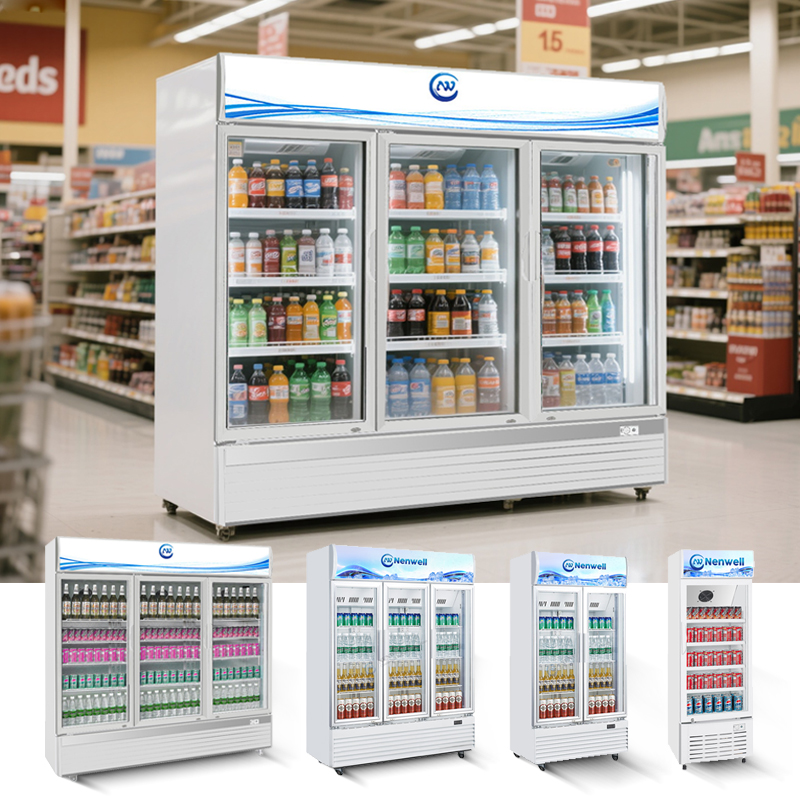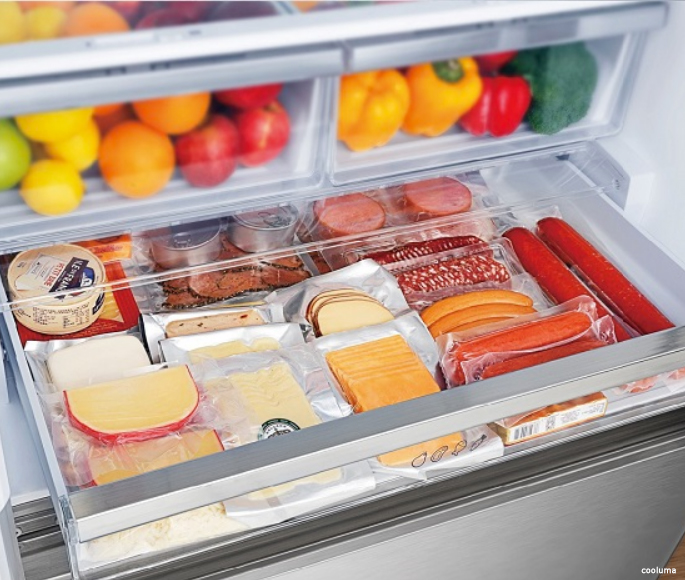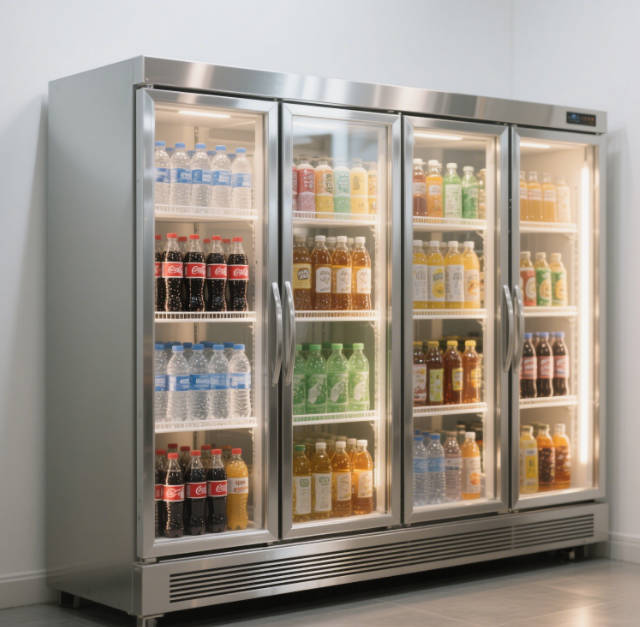
1. Display-Centric Design: Maximize Product Visibility and Impulse Sales
The primary goal of supermarket island freezers is to showcase frozen products while keeping them properly chilled—and their design is engineered around this priority. Unlike traditional freezers that prioritize storage over display, island models are built to attract shoppers’ attention from multiple angles, encouraging unplanned purchases.
360-Degree or Multi-Angle Visibility
Most island freezers feature transparent glass panels (usually tempered safety glass) on all sides or three sides, allowing shoppers to view products from any direction in the aisle. This eliminates the need for customers to open doors to check inventory, reducing cold air loss (critical for energy efficiency) and improving the shopping experience. For example, ice cream island freezers often use curved glass fronts to enhance visibility—shoppers can spot their favorite flavors from across the aisle, increasing the likelihood of picking up an extra carton.
Some high-end models also include LED interior lighting, which brightens products to make them more appealing (e.g., highlighting the vibrant colors of frozen fruits or the packaging of premium frozen meals). LED lights are preferred over traditional incandescent bulbs because they generate less heat (reducing the freezer’s cooling load) and have a longer lifespan, lowering maintenance costs.
Open-Top or Semi-Open Design (for Impulse Categories)
A subset of island freezers—often used for high-impulse items like ice cream, popsicles, or frozen snacks—features an open-top or semi-open design (with a low glass barrier instead of a full door). This design removes barriers to access: shoppers can reach in and grab products without opening a door, making impulse purchases faster and more spontaneous.
To mitigate cold air loss from open tops, these models use air curtains—a continuous stream of cold air that forms an invisible barrier above the unit. While air curtains do consume slightly more energy than fully enclosed doors, the boost in sales from improved accessibility often offsets this cost for retailers.
2. Spacious and Flexible Storage: Accommodate Diverse Frozen Goods
Supermarkets stock a wide range of frozen products, from small items (e.g., frozen peas, single-serve meals) to large packages (e.g., family-sized frozen pizzas, bulk seafood). Island freezers are designed with versatile storage configurations to handle this diversity, ensuring efficient use of space while keeping products organized.
Adjustable Shelving and Compartments
Nearly all commercial island freezers come with height-adjustable shelves (usually made of corrosion-resistant wire or reinforced glass). Retailers can reconfigure these shelves to fit different product sizes—for instance, lowering shelves to stack tall ice cream tubs or raising them to display small frozen snack packs. Some models also include removable dividers to separate product categories (e.g., separating frozen vegetables from frozen meats), making it easier for shoppers to find items and reducing restocking time for staff.
For specialized products like frozen seafood or delicate pastries, some island freezers offer drawer-style compartments at the bottom. These drawers provide sealed storage, protecting fragile items from damage and maintaining consistent temperatures—critical for preserving the quality of high-value goods like frozen shrimp or croissants.
Generous Capacity for High-Volume Sales
Island freezers typically have larger capacities than upright or undercounter models, ranging from 20 to 60 cubic feet (or more for custom-built units). This allows retailers to stock high-volume items (e.g., frozen turkeys during holidays, popular frozen meals) without frequent restocking. For example, a standard 40-cubic-foot island freezer can hold up to 300–400 frozen meal packages or 50–60 large ice cream tubs, ensuring inventory stays full even during peak shopping hours.
3. Advanced Cooling Systems: Maintain Stable, Low Temperatures
Frozen goods require consistent temperatures between -18°C to -22°C (-0.4°F to -7.6°F) to prevent spoilage and maintain texture (e.g., avoiding ice crystal formation in ice cream). Supermarket island freezers are equipped with robust cooling systems that deliver reliable performance, even in high-traffic, warm store environments.
Forced-Air (Air-Cooled) Circulation
Virtually all commercial island freezers use forced-air cooling systems (instead of direct-cool systems) to distribute cold air evenly. These systems use fans to circulate air from the compressor and evaporator coils throughout the unit, eliminating hot spots that could cause some products to thaw while others remain frozen. Even temperature distribution is especially important for open-top models, where warm air from the store can seep in—forced-air systems quickly counteract this to keep temperatures stable.
Many modern models also include digital temperature controls with LED displays, allowing store staff to monitor and adjust temperatures with precision. Some units even have temperature alarms that sound if the internal temperature rises above the safe range (e.g., due to a broken air curtain or a power surge), helping retailers avoid costly product loss.
Energy-Efficient Compressors and Insulation
Supermarkets operate freezers 24/7, so energy efficiency is a key concern for reducing utility costs. Island freezers are designed with two critical features to minimize energy use:
- High-efficiency compressors: Modern units use inverter compressors or scroll compressors, which adjust their speed based on cooling demand (instead of running at full power constantly). This can reduce energy consumption by 20–30% compared to older, fixed-speed compressors.
- High-density insulation: The walls and lids of island freezers are filled with thick, closed-cell polyurethane insulation—this material has excellent thermal resistance, preventing cold air from escaping and warm air from entering. Some premium models also use vacuum-insulated panels (VIPs) for even better insulation, especially in glass doors, where heat transfer is more common.
Many island freezers also carry Energy Star certification, meaning they meet strict efficiency standards set by the U.S. Environmental Protection Agency (EPA). An Energy Star-certified unit can save retailers $100–$300 annually in energy costs compared to non-certified models.
4. Durable Construction: Withstand Heavy Retail Use
Supermarket island freezers endure constant use: shoppers open doors (or reach into open tops) hundreds of times daily, staff restock shelves frequently, and cleaning crews wipe down surfaces regularly. To withstand this wear and tear, these units are built with rugged, commercial-grade materials.
Stainless Steel and Reinforced Exteriors
The exterior frames and base of most island freezers are made of 304-grade stainless steel—a material that resists rust, scratches, and stains, even when exposed to spills (e.g., melted ice cream) or cleaning chemicals. Stainless steel is also easy to wipe clean, which is critical for maintaining food safety and a professional appearance.
The base of island freezers is often reinforced with heavy-duty metal or plastic feet to support the unit’s weight (which can exceed 500 pounds when fully stocked) and prevent tipping. Some models also have casters (lockable wheels) to make it easier for staff to move the unit for deep cleaning or floor maintenance—though casters are typically optional, as most island freezers are intended to stay in fixed positions.
Impact-Resistant Glass and Components
The glass panels on island freezers are made of tempered safety glass, which is 4–5 times stronger than regular glass. If it does break (a rare occurrence), tempered glass shatters into small, rounded pieces instead of sharp shards, reducing the risk of injury to shoppers or staff.
Other components—like door handles (on enclosed models) and shelf brackets—are made of reinforced plastic or metal to withstand repeated use. For example, door handles are often ergonomically designed and thickened to resist breaking, even if shoppers pull on them forcefully.
5. Mobility and Space Efficiency: Adapt to Store Layouts
Supermarkets frequently rearrange aisles and displays to keep the shopping experience fresh. Island freezers are designed to be adaptable, allowing retailers to reposition them without major hassle—while also maximizing use of floor space.
Compact Footprint for Aisle Placement
Despite their large internal capacity, island freezers have a relatively compact footprint. Most standard models measure 3–5 feet wide, 2–3 feet deep, and 3–4 feet tall —small enough to fit in the middle of standard store aisles (which are typically 8–10 feet wide) without blocking traffic. This compact design lets retailers place multiple island freezers side by side (e.g., one for ice cream, one for frozen meals) to create a "frozen food zone" that’s easy for shoppers to navigate.
Optional Casters for Flexibility
As mentioned earlier, many island freezers offer lockable casters as an add-on feature. These casters let staff roll the unit to a new location (e.g., moving an ice cream freezer closer to the checkout area during summer) or into a storage room for maintenance. Lockable casters ensure the unit stays securely in place once positioned, preventing it from shifting when shoppers lean on it or staff restock shelves.
6. Hygienic and Easy-to-Clean Features: Meet Food Safety Standards
Supermarkets are required to meet strict food safety regulations, and island freezers are designed with features to simplify cleaning and prevent cross-contamination.
Removable, Dishwasher-Safe Components
Shelves, dividers, and door gaskets (on enclosed models) are often removable, making it easy for staff to clean them thoroughly. Many of these components are also dishwasher-safe, saving time compared to hand-washing. For example, wire shelves can be removed, wiped down to remove crumbs or spills, and then run through a commercial dishwasher to sanitize them—critical for preventing the growth of bacteria like Listeria (which can thrive in cold environments).
Sealed Interiors and Drainage Systems
The interior of island freezers is sealed to prevent food particles from getting trapped in hard-to-reach areas (e.g., between the shelf brackets and the walls). This sealed design also makes it easier to wipe down the interior with a damp cloth and food-safe cleaner.
Open-top island freezers often include built-in drainage systems to collect melted ice or spills. These systems have a small drain pan at the bottom of the unit, which can be removed and emptied regularly—preventing standing water from accumulating and creating a slip hazard or promoting mold growth.
7. Branding and Customization: Align with Store Identity
Island freezers are not just functional—they’re also marketing tools. Retailers can customize these units to align with their brand or promote specific products, enhancing the overall store aesthetic and driving sales.
Customizable exteriors: Some manufacturers offer custom color options for the stainless steel exterior (e.g., black, white, or brand-specific hues) or allow retailers to add vinyl wraps with logos, promotions, or product images (e.g., a wrap featuring a popular ice cream brand on an ice cream freezer). - Branded shelving and signage: Retailers can add custom shelf labels or LED light boxes to the front of the unit to highlight promotions (e.g., "2 for $5 on Frozen Meals") or product benefits (e.g., "Gluten-Free Options Inside"). - Size customization: For larger supermarkets or specialty stores, manufacturers can build custom-sized island freezers to fit unique floor spaces (e.g., a long, narrow unit for a small aisle or a square unit for a central display area).
Conclusion: Why Supermarket Island Freezers Are Indispensable
Supermarket island freezers stand out for their unique blend of functionality, durability, and marketing appeal. Their display-centric design drives impulse sales, while their advanced cooling systems and durable construction ensure frozen goods stay fresh and safe. From adjustable shelving to energy-efficient compressors, every feature is tailored to the demands of retail environments—where accessibility, reliability, and cost-effectiveness are key.
For retailers, investing in high-quality island freezers is more than just buying a storage unit—it’s investing in a tool that enhances the shopping experience, reduces operational costs (through energy efficiency and low maintenance), and boosts revenue through better product visibility. As consumer demand for frozen foods continues to grow (driven by convenience and longer shelf life), island freezers will remain a staple in supermarkets, adapting to new trends (e.g., smart temperature monitoring, eco-friendly refrigerants) while retaining their core characteristics of performance and practicality.






This batch of products seems to be of good quality.